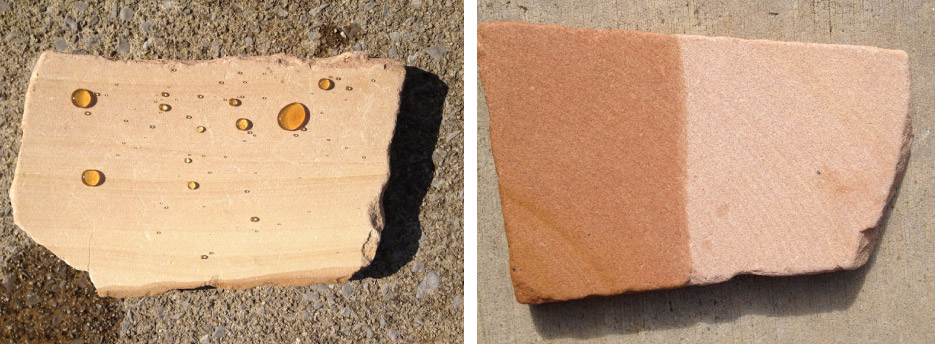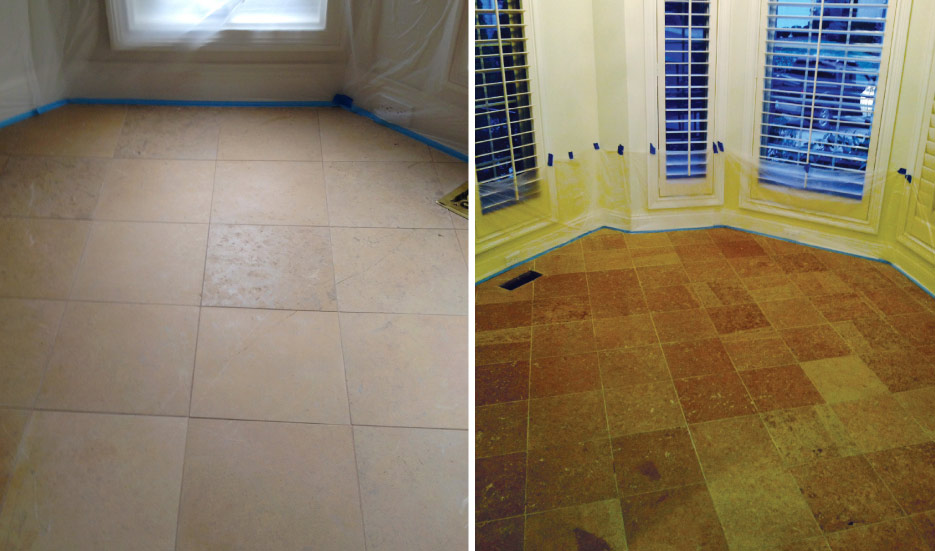Restoration and Maintenance Corner: Chemistry 101 – Part 2
Bob Murrell
M3 Technologies
Photos by Bob Murrell
Happy New Year to all you Slippery Rock readers out there!
As restoration and maintenance professionals, we regularly deal with chemicals. It only makes sense that we should have some basic chemistry knowledge, and perhaps a little bit more.
So I sat down with a friend who also happens to be a bio-chemist with CoreChem.
John Rippetoe is one of those people who is a natural-born teacher and loves sharing his knowledge of chemistry with others. I came to John with a list of topics that I thought would be relevant to our industry.
In Chemistry 101 Part 1, we covered the pH scale. In Part 2, we are going to cover other aspects of chemistry like densifiers, consolidators, impregnators and sealers, safety, and other issues.
Densifiers
Densifiers are typically used for concrete, terrazzo, and even limestone. There are different types of liquid silicate hardeners, but mainly the sodium, potassium, and lithium densifiers are the most common. There are also colloidal products on the market, which simply drive materials that harden into the surface.
All of these silicate densifiers react with the calcium hydroxide, which is a byproduct of cement hydration (water migrating up through and evaporating from the cement). Calcium hydroxide is actually not very hard and when it reacts with carbon dioxide, it leaves behind a white powder on the surface, a process called dusting. When the densifier reacts with the calcium hydroxide, it forms calcium silicate hydrate or CSH. CSH is what gives concrete much of its strength and hardness at the surface, while preventing dusting.
Lithium silicate reacts with the calcium hydroxide faster and better than both the sodium and potassium silicate materials, without generating any hazardous waste water due to scrubbing and removal. Lithium silicate densifiers are also easier to use – simply spray and massage into the surface with a microfiber applicator, then allow to dry. There is no scrubbing or removal process.
Consolidators
Consolidators work similarly to colloidal densifiers by strengthening the stone through a bonding process. Many consolidators use a silicic ethyl ester to form silicon dioxide, which is a glass-like material, and very hard. This SiO2, which has very similar properties to the original stone, replaces the lost cement of the stone due to weathering and moisture-related issues. These consolidators are very useful for deteriorating limestones and sandstones. Consolidators can also incorporate an impregnator/sealer so that once the material has been strengthened, it is also protected from liquid penetration and the elements.
Sealers
Speaking of protection from liquid penetration and the elements, let’s discuss the use of sealers, color enhancers, and true impregnators. In my view, sealers are necessarily topical coatings, which can be either water-based or solvent-based. Sealers give the best protection against staining, etching, wear, and most other negative issues. However, they have their own negative issues, as well, such as a possibly significant change in the natural appearance of the material. Sealers most always take away from the natural beauty that stone and similar surfaces exude.
They can make the surface look plastic, which is exactly what takes place when it is applied. They can also discolor (turn yellow), trap moisture (cloud up), and show scuffing and wear. In my book, sealers are pretty much for textured stone only, and concrete and terrazzo. You see, concrete guard products would be classified as sealers, too. Guard products, which are typically a high solids acrylic, can protect an acid stain on concrete, polished concrete, and polished terrazzo from acid etching and other chemical contaminants. This is why guards are used in grocery stores and other similar high-traffic commercial applications.
 |
|
Above, left: Sandstone with Majestic Low Odor Impregnator applied. The test liquid beading up is Southern sweet tea. Above, right: Sandstone — half with color enhancer applied. |
 |
|
Above, left: Limestone floor before applying color enhancer. Above, right: Limestone floor after applying color enhancer— what a color difference! |
Color Enhancers
 |
|
Applying color enhancer to Tennessee Crab Orchard sandstone really brings out the beauty of this stone. |
Color enhancing products are basically a penetrating sealer, which is like a cross between a sealer and an impregnator. They don’t really leave a topical coating, per se, but do fill the pores with resinous materials. These resins are what help bring out or enhance the natural colors of the stone. Typically, color enhancing sealers are solvent-based but there are a few water-based color enhancers around. Just remember that solvent-based products most always penetrate faster and deeper than water-based products. Color enhancers are really only for more porous materials with lots of surface area like textured slate, flamed granite, sandstone, and possibly a coarse-honed limestone, marble, or granite.
So let’s say you want protection from liquid spills such as grease, oil and water-borne contaminants, but you have a polished material, or don’t want any appearance change. Well, this is where a true impregnator comes into play. Impregnators differ from sealers and color enhancers in that they use either a solvent or water to carry their fluorinated copolymer into the pore structure of the material. Once deposited, the carrier evaporates. They offer little to no appearance change and allow the stone to transpire water vapor (breathe) all while protecting the surface from liquid spills. They will not, however, give complete protection from acid etching on calcium-based materials, even though they can help minimize the damage. Impregnators are the staple for protection on polished kitchen countertops.
Impregnators can also be hydrophobic (water resistant) or oliophobic (oil and grease resistant). If the impregnator is oliophobic, it is also hydrophobic, but not the other way around.
So to sum up, many of the above referenced products are solvent-based or have a high level of VOCs (volatile organic compounds). Solvents are becoming more and more restricted in their use and transportation. For example, in California, solvent-based impregnators can only be shipped in containers of quart size or smaller. This could possibly increase your cost of doing business – just something to keep in mind.
Note: Every contractor should have, on hand and available for inspection, the proper new 16 section internationally standardized SDS for each chemical product that is in inventory and/or used on every project. It is the law. The proper use of PPE (personal protective equipment), product use and disposal, and other pertinent health and safety information will be given on each product SDS.
As always, I recommend submitting a test area to confirm the results and the procedure prior to starting a stone or hard surface restoration or maintenance project. Also the best way to help ensure success is by partnering with a good distributor that knows the business. They can help with technical support, chemical product purchase decisions, logistics, and other pertinent project information.
Bob Murrell has worked in the natural stone industry for over 40 years and is well known for his expertise in natural stone, tile and decorative concrete restoration and maintenance. He helped develop some of the main products and processes which revolutionized the industry, and is currently the Director of Operations for M3 Technologie